
Title: The Underworld of Oregon Caves National Monument
Author: Roger J. Contor
Release date: April 12, 2019 [eBook #59262]
Language: English
Credits: Produced by Stephen Hutcheson and the Online Distributed
Proofreading Team at http://www.pgdp.net

by
ROGER J. CONTOR
Published by
Crater Lake Natural History Association

Produced in cooperation with the
National Park Service
Copyright 1963 by
Crater Lake Natural History Association
Printed in U.S.A.
© CRAFT PRINTERS, INC
1205 Klamath Avenue
Klamath Falls, Oregon 97601
Roger J. Contor attended the University of Idaho and Montana State College, concentrating in the fields of zoology, botany, forestry, and big game management. His association with the National Park Service began as a seasonal employee in 1949 in Yellowstone where he served intermittently in various capacities into 1955. Later that year, he joined the permanent staff of the National Park Service as a park ranger, serving in Yellowstone, Rocky Mountain, and Bryce Canyon National Parks.
In 1960, Mr. Contor became management assistant for Oregon Caves National Monument, where he remained until early 1962. He then returned to Rocky Mountain National Park, also as a management assistant. He is a member of The Wildlife Society and Phi Beta Kappa and has authored wildlife articles for National Parks Magazine, Field and Stream, Outdoor Life, Wyoming Wildlife and Denver Post.

CAVE TOUR

Paradise Lost
Three tired men unsaddled their horses where the mountain stream disappeared into the ground. They had fought their way 15 miles over wild, rugged mountains since leaving Williams Valley at dawn. Yet rest was far from their minds. Hurriedly they stuck tallow candles into lanterns made from tin cans, untied a lariat from a saddle, then walked down the valley. They stopped where the stream, now larger, reappeared from a shadowy crevice under a cliff.
“This must be it,” said one of them eagerly, “just like Davidson said.” And with mixed feelings of excitement, fear, and the overwhelming grip of adventure, they followed flickering candlelight into the dark opening. Tales of persons lost for days in other caves were fresh in their minds, so they uncoiled a ball of string as they went. Later they could follow it back out.
Soon they knew the Davidson story was true, more than true. Crawling from one chamber to another, they found a fairyland of weird grottoes and exquisite stone formations—pillars and spires, drapes, frozen waterfalls and grotesque forms—in shapes and sizes beyond their imaginations. Some they named from resemblance to familiar objects. At others they could only stare in awe and wonder how can it be? Using the rope in steep places, they probed upward into another level of caverns where they were thrilled to find even more elaborate formations. At one place they wrote their names and the date, July 11, 1879. Here and there they saw 2 evidence left by the few others who had entered the cave in the five years since it was discovered by their neighbor, Elijah Davidson. On and on they explored, returning to the entrance only when their last candle was growing short. Outside, stars lighted a midnight sky. Exhausted, happy, they vowed to return, then fell into bedrolls.
Thus early visitors responded to the lure of Oregon Caves: to see the unseen and to know the unknown. Today, thousands of people enjoy the caves under less demanding circumstances. Yet the joy of personal discovery endures. For each visitor about to enter the cave, the thrill of learning something new and interesting about the earth beneath us is born anew.
Throughout the world, caves loom large in the scope of history. Early man used them as dwelling and fortifications. Fugitives hid in them and thieves used them to cache their loot. Others have found them fine places to grow mushrooms. During the War of 1812 and the Civil War, Americans mined certain caves for saltpetre which was desperately needed to make gunpowder. Much of our knowledge of long extinct mammals has been gleaned from perfectly preserved remains, and even prehistoric drawings, uncovered by cave-probing scientists.
To most of us, however, the greatest value of caves is the delight of seeing the strange beauties wrought by nature through countless centuries. And from this comes the challenge to understand the imperceptibly slow, relentless forces which produce them. This booklet sketches the processes which form, alter and eventually destroy caves. It is an attempt to share present knowledge with those who visit Oregon Caves National Monument.
Before going on, let us define the word cave as we consider it here. True caves are formed in soluble rock—limestone, marble, gypsum or dolomite. They usually contain some redeposited mineral in the form of stalactites, etc. As most caves occur in limestone, the term limestone cave is often used to describe any true cave, even though it may actually occur in dolomite or marble. The cave-forming process will be basically the same for either type of soluble rock. We exclude from this definition mines, lava tubes, ice caves, and sandstone depressions such as those used by cliff-dwellers in the Southwest. While they are “holes in the ground,” they are formed in different ways than are the limestone type caves, and therefore are not usually referred to in geological discussions of caves.
If we could turn back some 180 million years into geologic time, we would find the North American continent a much different place. This was the Triassic Period. Early dinosaurs thrived in primitive forests over much of the United States. The area around southwestern Oregon was not yet part of the continent; it was a shallow arm of the sea. Smoldering volcanoes jutted out as cone-shaped islands or poured forth fumes and lava from the distant mainland.
During quieter centuries the age-old process of life and death went on within the sea waters. Fish, clams, coral—even tiny one-celled creatures too small to be seen—extracted a mineral called calcium carbonate from the water. With it they built bones, shells and skeletons. When these animals died, their hard parts settled to the ocean bottom. Gradually, layers of calcium carbonate were built up.
At the same time certain chemical functions of ocean plants extracted carbon dioxide from the water and caused still more calcium carbonate to precipitate and add to the sediments. The layers deepened. Eventually the weight of overlying sediments and the ocean above compressed them into a rock called limestone.
In different parts of the sea, and under varied conditions, other ocean sediments were deposited. Near the shore, wave-swept sand accumulated and eventually became sandstone. Fine silt and clay carried to the sea by rivers settled in bluish layers which were to become shale. Near rocky headlands, course gravel deposits became cemented into a hard mass called conglomerate.
This steady formation of sedimentary layers was periodically interrupted by volcanic activity. Heavy clouds of volcanic ash and fragments settled into the sea. Molten lava poured into shallow bays or welled up from subsurface volcanoes to mix with calcium carbonate muds. When volcanism subsided, the seas went back to the quiet deposition of limestone. Today at Oregon Caves we find evidence of this interbedding of sedimentary and volcanic materials. An example of such interbedding can be seen above the parking area near the Chateau.

Marble outcrop
Thus mixed deposits of volcanic and ocean sediments continued to collect for several million years. Apparently this steady transfer of material from one part of the earth’s crust to another created a crustal imbalance. The edge of the continent was under a strain. Then, like an accordion, a tremendous folding of the lands along the Pacific Coast occurred.
The floor of the sea was lifted above the ocean’s surface to form a new coast line in this vicinity. Violent stresses in the earth’s crust created intense heat and pressure which changed, or metamorphosed, the rocks. Shales were altered to slate. Sandstone became quartzite. Limestone became the marble so important to Oregon Caves. Even the volcanic materials were altered considerably from their original form. The resultant geological belt composed of inter-bedded layers of slate, quartzite, marble, and metamorphosed volcanics is known as the Applegate Group.
After the uplift, there was a long period of crustal stability. The folded mountains were eroded away and the area became a flattened plain near sea level. As a result, its streams were sluggish and meandered slowly to the ocean. Then, in various stages, the plain was uplifted in another period of crustal adjustments which produced a flat-topped plateau, so to speak, known as the ancient Klamath Peneplane. This restored the vigor of the stream erosion, which helped at times by glacier sculpture, dissected the plateau into the mountains we know today. The Siskiyou Range surrounding Oregon Caves National Monument is part of the Klamath Mountain System.
Let us focus on one of the ancient marble layers of the Applegate Group, for this is the rock strata in which Oregon Caves were formed. It is actually a narrow, tilted belt, varying in thickness up to 400 feet. It dips eastward into the earth at an angle of about 60° and can be followed in a southwest-northeast direction for about 4 miles along the west shoulder of Mt. Elijah (see illustrations on page 4). Examination of the marble layers inside the exit tunnel or the outcrop at the beginning of Cliff Nature Trail reveals many fractures caused by the stresses of upheaval. Some are vertical cracks, but there are also many cross fractures at varying angles.

Oregon Caves marble—8 inches wide
When tested for chemical composition, Oregon Caves marble samples have averaged 93 percent pure calcium carbonate (CaCO₃). Its bluish color is derived from the remaining percentage of impurities. Without these, it would be white. A good example of nearly pure calcium carbonate is the white chalk used on blackboards.
Without this belt of soluble marble, and without the fractures within it, natural processes could not have produced the “Marble Halls of Oregon.” It is the foundation, the framework, and the raw material of the caves.
The first requirement in the genesis of Oregon Caves—the right kind of rock—was met. Next came the erosive agent which was to carve it into caverns. This was the flow of underground water.
The present rainfall in this area averages 50 inches a year. During the many thousands of years the caves were forming, the climate may have varied from wetter to drier many times, but it is safe to assume this has always been an area of relatively heavy precipitation. The steep, mountainous terrain and deep-cut valleys of southwestern Oregon are characteristic of aggressive stream erosion that goes hand-in-hand with a healthy supply of rainfall.
Some of the rain evaporates and returns to the air. Some of it soon runs into streams and is carried rapidly to the ocean. The rest of it seeps into the ground where it is delayed for a time in its inevitable return to the sea. Under the force of gravity, it trickles downward rather steeply through joints and cracks in the rocks, or seeps between particles of sand, gravel, or clay. Below the ground surface it joins a zone of saturation, or phreatic zone.
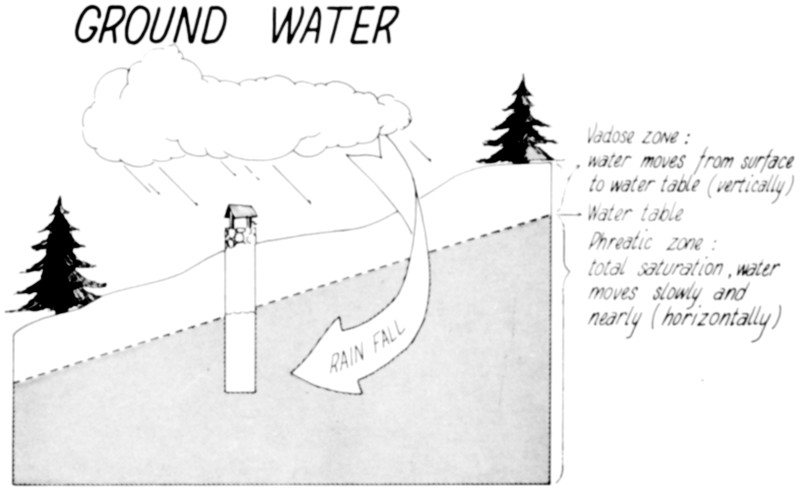
GROUND WATER
Here cracks, pores, and all spaces within the rock are completely filled with water. There are no airspaces. Water movement within the phreatic zone is comparatively slow, varying from a few inches a year to a few feet a day, depending upon the permeability of the rock structure. And the movement is usually horizontal, following the contours of the land in the same direction as surface streams. Eventually this water will find its way back to the surface at a lower elevation where it usually emerges as a spring. It is phreatic water which feeds the mountain streams and rivers many weeks or months after the last rainfall. It might also be pumped from a well for human use. A large portion of the earth’s population depends upon well water from these great underground reservoirs.
How deep does phreatic water exist? This depends upon the porosity of the rock, or its ability to contain water. Most mines that penetrate many hundreds of feet encounter little water at great depths. Pressure of the overlying rocks is so great that open spaces capable of holding water cannot exist. So the earth’s crust contains available well water only in restricted zones not far from the surface. The top of the zone of saturation is called the water table. It is here that the most rapid flow of phreatic water occurs, for the joints and interspaces are wider nearest the surface. Between the water table and the surface is the vadose zone, in which the spaces are partly filled with water and partly filled with air. (See illustrations on page 7). Vadose water content varies greatly with weather conditions. As rainfall is scant in southwest Oregon during the summer, visitors find the caves relatively dry at that time. In the winter, however, the passages will be veritably “raining” vadose water within a few days after snow or rain.
The water table itself is more stable, but varies somewhat from winter to summer, or during extended periods of unusually wet or dry seasons. Its lowest possible level is ultimately controlled by the elevation of the largest nearby surface stream or lake, which acts as a base level. When the streams and lakes are lowered by erosion, the water table of a given locality keeps pace by slowly sinking until eventually it lies scarcely above sea level.

Solution Rills in Ghost Room ceiling
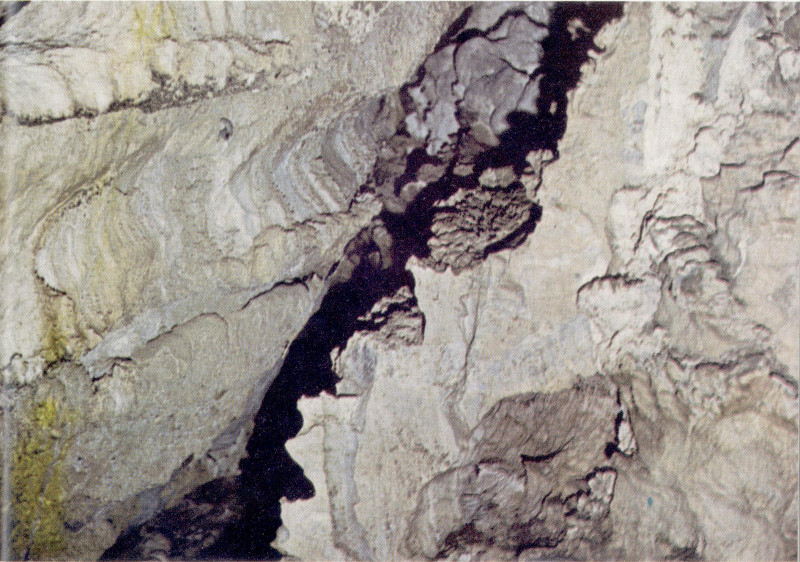
Crack widened by solution—Watson’s Grotto
Rain falling on the mountains above the cave seeps into the surface cover of vegetation and humus. Here it absorbs carbon dioxide released from the process of organic decay. Seeping further through the vadose zone and down to the water table, this water carries many times the normal amount of carbon dioxide found in the atmosphere. In fact, it becomes acid. For water (H₂O) and carbon dioxide (CO₂) unite to form a mild solution of carbonic acid (H₂CO₃). In this manner, phreatic water is constantly charged with mild acids. Not the kind that harm us, of course. The fountain water by the chalet, and probably that in your home, is actually mild carbonic acid. So is bottled pop.

| SOLUTION | ||||
|---|---|---|---|---|
| RAIN | + | CARBON DIOXIDE MOLECULES | = | MILD CARBONIC ACID |
| (H₂O) | (CO₂) | (H₂CO₃) | ||
| CARBONIC ACID | + | CALCIUM CARBONATE MOLECULES FROM MARBLE STRATA | = | CALCIUM BICARBONATE SOLUTION |
| (H₂CO₃) | (CaCO₃) | (CaH₂(CO₃)₂) | ||
| DEPOSITION | ||||
| CALCIUM BICARBONATE REACHING CAVE AIR | CARBON DIOXIDE, CALCIUM CARBONATE | FOR EACH CARBON DIOXIDE MOLECULE ESCAPING INTO CAVE AIR, AN EQUIVALENT MOLECULE OF CALCIUM CARBONATE MUST BE REDEPOSITED AS SOLID DRIPSTONE, FLOWSTONE, ETC. | ||
It was thus that phreatic water, charged with soil acids, percolated century after century through cracks in the marble. The acids ate away at all exposed rock surfaces—sideward, downward, and upward. (The solution rills in the original Ghost Room ceiling reveal the upward dissolving of water-filled cavities, see illustration page 9). To fully understand this, we must recall that the marble is 93 percent calcium carbonate (CaCO₃). To dissolve it, carbonic acid mixes with the calcium carbonate to form an unstable liquid compound called calcium bicarbonate, (CaH₂(CO₃)₂). The removal of solid calcium carbonate in 11 a liquid is the key cave forming process and is called solution (see illustration page 10). In Watson’s Grotto we find several examples of early crack-widening by phreatic solution (see illustration page 9).
The enlarged cracks allowed faster movement of water against an increased surface area, and a subsequent increase in solution activity. Partitions between them fell apart and were dissolved. A series of water-filled passages evolved deep underground. Their pattern and orientation followed the pre-cave network of joints and cracks in the original strata. Gradually the openings were further enlarged into the cave system we know today.
There is more to it than that, of course. You may ask, “Why aren’t there caves continuously throughout the belt of marble? The joints and cracks are everywhere. And certainly all the marble near the surface has been subjected to ground water action at some time or another. Why are Oregon Caves limited to one particular part of the marble belt?”
The answer to this involves several considerations. To begin with, we do find small cavities and solution cracks throughout the exposed marble. So there has been varying degrees of solution activity nearly everywhere, although not sufficient to produce caverns comparable to Oregon Caves.
Secondly, we must reconsider the mineralized water, calcium bicarbonate. We called it an unstable compound, meaning it will alter readily with slight changes in conditions. Once the amount of carbon dioxide dissolved in the water has united with an equivalent amount of calcium carbonate (marble), the solution is saturated. No more marble can be dissolved until additional carbon dioxide is absorbed by the water. If the solution loses some of its carbon dioxide into the air, then an equivalent amount of calcium carbonate must be redeposited as solid stone. The balance can be delicate. In an underground pool of mineralized water, solution may be going on at one end of the pool and deposition at the other.
So a state of chemical balance tends to develop in normal phreatic drift through the marble. Water saturated with minerals might easily move through many hundreds of feet of marble strata without further enlarging the openings. Instead, it might even deposit some of the dissolved minerals, filling small cracks and veins, possibly even blocking its own passage during dry cycles when phreatic flow is at a low ebb. The “dry” room in the cave is an example of vein filling. Clay, gravel, and other surface sediments can also be washed into the openings, plugging them up and halting further solution for a time. All these factors lead 12 toward a stabilization of the solution process. Openings and small passages continue to be formed, yet normal phreatic movement at Oregon Caves seems to lack the force for large scale cave sculpture.
This opens the door to our third consideration; we know the greatest amount of solution occurs in the water table zone. Therefore, to gain the impetus needed to carve out a cave system, some local condition must have increased the water table flow in the immediate vicinity of Oregon Caves. The solution process was magnified as larger quantities of freshly acidic phreatic waters were channeled into a restricted zone. Surging on, they scoured through the marble, dissolving larger volumes of calcium carbonate and sweeping it away. The early solution pattern of enlarged cracks had set the stage for the onset of this swift phreatic erosion. But some geologically sudden event was necessary to trigger the forces which completed the act.
We do not know exactly what the triggering action was. We know that the water table either received a sudden increase in supply from surface drainage, or found a larger or lower outlet downslope which tapped phreatic water over a widespread zone and channeled it through a localized area. There are several possibilities.
1. A perched water table may have been held in the cave zone by a lower and impervious layer of rock. This barrier may have been suddenly cut through by erosion, as if the plug were pulled in a bathtub. The perched water would now pass through the barrier, rather than over it, evacuating parts of the former phreatic zone, and inducing surface streams to channel underground through the same route. With such a subterranean diversion of water from a higher to a lower drainage pattern, the water table flow would increase considerably. A cave-forming condition would exist.
Several small streams lose their identity and sink into the ground a few hundred yards above the caves. Doubtless, they join the water table inside the caverns to emerge at the entrance as the River Styx (called Cave Creek outside). Possibly they aided in the early stages of cave formation in a manner described above.
2. It is difficult to imagine what the surface topography was like when the cave was forming, yet we know it hasn’t always been the same. The mountains were higher. The streams occupied higher positions in the valleys. The ridges lay in a somewhat different pattern. Now and then stream piracy, or drainage rearrangement, took place when a rapidly eroding stream cut away the ridge separating it from a 13 less active stream. Suddenly the slower stream was diverted into the drainage system of its captor. Both surface and phreatic waters of the aggressive drainage were increased. The flow at the water table speeded up in response.
If stream piracy occurred in the drainage overlying the caves, it might have played an important part in cave carving.
3. Nor can we omit the conditions that occurred here during periods of glaciation. Shifting masses of ice and glacial debris characteristically cause damming and rechanneling of water in minor stream valleys. The temporary results are similar to stream piracy. Coupled with this is the great volume of water which drains from melting glaciers. Evidence of partial glaciation in the Siskiyou Mountains lends serious consideration to its effect on early cave development.
The whole process might have involved all three of the above situations in varying degrees, for a “geologically sudden” event may take several thousand years. Several distinct levels of cave erosion indicate that the water table moved along at a certain level for a time, then rapidly dropped to a lower course where it was stable for another extended period. This was repeated until it now stands near the level of the River Styx.
Successively, the caverns at higher levels were drained and left empty. So as your tour climbs from the cave entrance to the highly developed sections near the Ghost Room, you encounter galleries that are progressively older. The first room inside the entrance, Watson’s Grotto, is the best example we have of a cavern “recently” drained.
A word about the River Styx. Above it in several places you can see very smooth walls left by the familiar erosive action of a stream. (See illustration page 14). Most of the cave walls show the more pitted, concave surface left by the acidic dissolving action of phreatic water. The water which produced the main cave system moved much slower than the River Styx, and over a wider area. The stream as we see it did not produce the cave. Rather, the caverns, when drained, left a free flowing course for ground water to channel into. The only true underground streams occur in caves. They are a by-product of the cave-forming process.

Smooth-walled erosion of River Styx
Surface erosion continued to tear away at the mountains. Streams cut their valleys deeper. In response, the water table gradually sank below the level of the caverns and they, in turn, were drained. Air entered the rooms. The basic excavation process was completed except for a few minor changes: In some places, vadose water continued to dissolve away portions of the cave ceilings into dome shapes. In other rooms previously drained, water re-flooded certain portions during wet cycles. And some rooms were filled with clay and gravel brought in from the surface, then washed clean again in later stages.
Most important is the entrance of air, which ushered in the second major stage in cave formation. The unadorned grottoes were now to be decorated. Nature, through the process of deposition, next created the eerie beauty which delights today’s cave visitors. In fact the process continues even now, for Oregon Caves are “live” caves, meaning they are still being decorated by natural deposition.
The weak carbonic acid in vadose water kept eating away the roof marble above the caves. Reaching the caverns, drops of vadose water evaporated into the air and left their load of calcium carbonate as thin layers of solid mineral. The amount left by each drop was infinitesimal, yet millions of drops eventually left thick deposits coated on the walls, ceilings and floors of the cave. The crusty white deposits in the Beehive Room are fine examples of deposition by evaporation. They were left there in much the same way as the coating in the bottom of a teakettle or steam iron.
However, evaporation is important only near the surface. Deeper inside Oregon Caves the relative humidity averages 98 percent. Evaporation here is almost non-existent. Instead, loss of carbon dioxide becomes the chief agent of deposition. We have learned that vadose water contains 25 to 90 times the normal amount of carbon dioxide found in the atmosphere. Much of it, of course, unites with calcium carbonate to form calcium bicarbonate solution. When this mineralized water reaches the caverns, large quantities of carbon dioxide are able to escape into the air due to the difference in carbon dioxide amounts in the water and air. The chemical balance is upset. For each molecule of escaping carbon dioxide, an equivalent molecule of solid mineral is deposited (see illustrations page 10).
An interesting side effect of the loss of carbon dioxide is experienced by the cave visitor. Although cave air is constantly replenished by outside air through natural exchange, it has a rather high carbon dioxide content due to release of this gas by vadose waters. This partly explains the heavy breathing you find necessary inside the cave, because the nerve centers which control our breathing are stimulated by a high percentage of carbon dioxide in the air we breathe. It also explains the odd “peroxide” odor many people notice when they reach the exit. The odor is oxygen. We notice it because our senses have become adjusted to slightly lower oxygen percentages inside the cave.

Cave deposits in Joaquin Miller’s Chapel
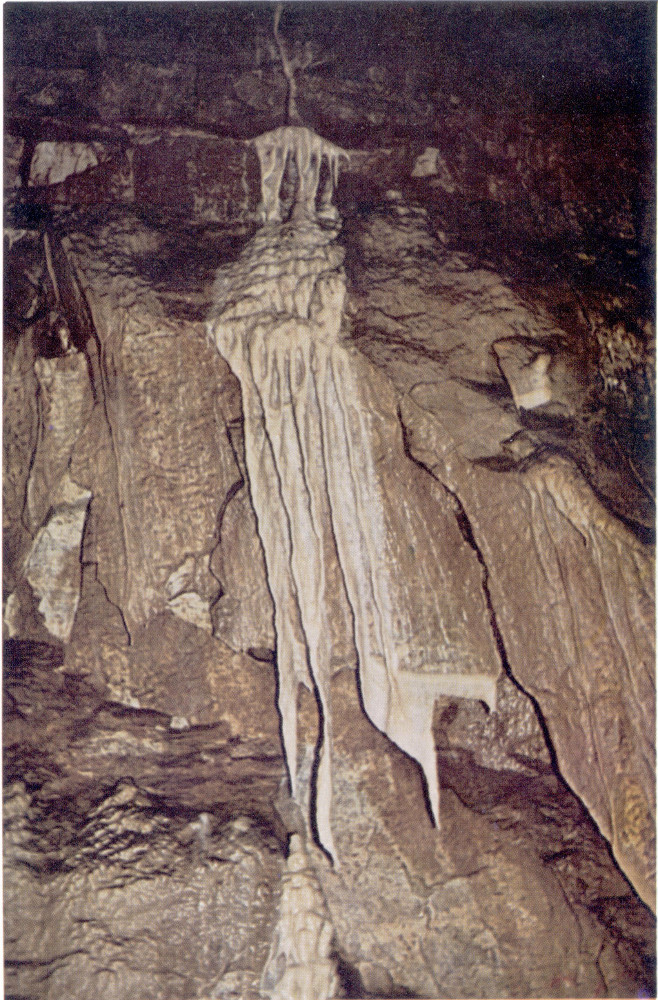
Drapery in Ghost Room
Cave deposits are collectively termed speleothems. Their variety is infinite: Those left by dripping water are called dripstone, and take on two basic forms—if they hang down from the ceiling they are called Stalactites, if they grow up from the floor they are stalagmites. The two may join together to form a column. Where the water drips rapidly and the loss of carbon dioxide is slow, stalagmite growth is favored because little deposition can take place on the ceiling. If the drip rate is slow and loss of carbon dioxide is rapid, stalactite formation is favored.

Formations on page 16
Contrasted with dripstone is flowstone—smooth layered deposits left along walls and floors by flowing water. In Joaquin Miller’s Chapel, flowstone deposits are many inches thick. (See illustration on page 16). A close look at the structure of dripstone and flowstone reveals six-sided crystals called calcite, which is merely the crystalline form of calcium carbonate. (See illustration on page 19). Banded crystal layers in cave deposits are often called alabaster, or cave onyx. These can be easily seen at the “wishing post.”
Other shapes and forms accrue. Flowstone forming on backsloping walls tends to produce graceful sheets called drapery. (See illustration on page 17). Reddish bands may develop in drapery where iron oxide is imbedded with the calcite. Contrasted with the pure white layers of calcium carbonate, this gives the appearance of bacon. Good examples of “bacon” can be seen in the Ghost Room.
Most shapes and forms of dripstone and flowstone are occasionally duplicated by freezing water. Stalactites form on the edges of roofs, stalagmites form on the sidewalk beneath them, etc. But one of several cave formations which can’t be thus copied is the soda straw (see illustration page 20). Deposition begins as a ring of calcium carbonate around a water drop. The ring has the unique feature of being a single crystal. As 19 more drops leave their deposits, the ringed crystals form one on the other to create a tube. The water continues to seep through the inside of the tube, eventually producing the fragile, crystalline pipe with the obvious name.
The diameter of a soda straw is apparently determined by the specific gravity and surface tension of water, for they are all nearly the same diameter, about one-quarter inch. In a cave in western Australia one soda straw has reached a length of 20 feet, 6 inches, yet is still only one-quarter inch in diameter. If the drip rate decreases, the tip of the soda straw may sometimes seal itself closed.
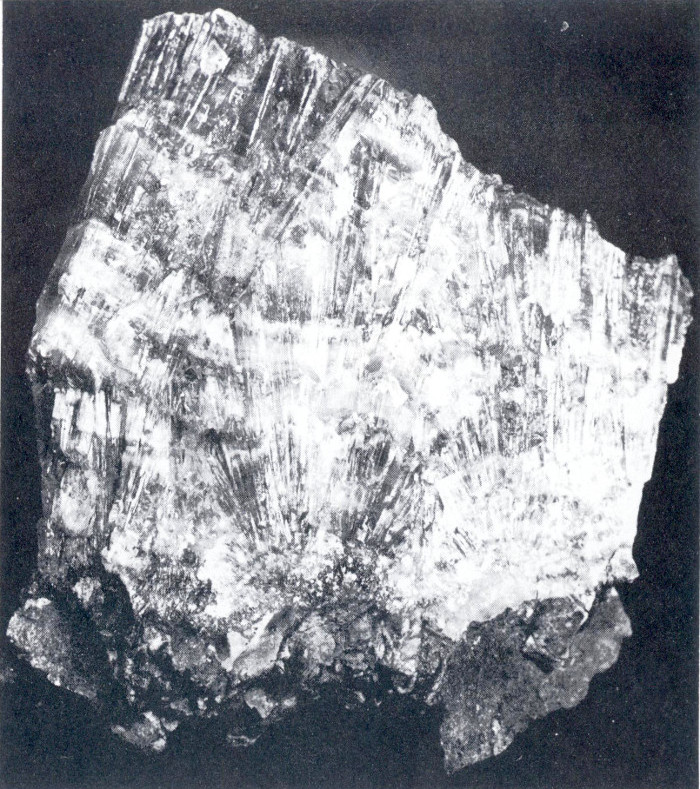
Calcite crystals in layer of flowstone, 8 inches high.

Some speleothems apparently defy gravity. Now and then internal hydrostatic pressure causes secondary formations to project out from others in unusual directions. These are helictites (see illustration on page 21). A related form is popcorn (see illustration on page 22), the mat of small nodules which coat the “beehive” and other objects in the cave. Also called “cave coral,” popcorn can form under water or along wet walls in response to air currents.
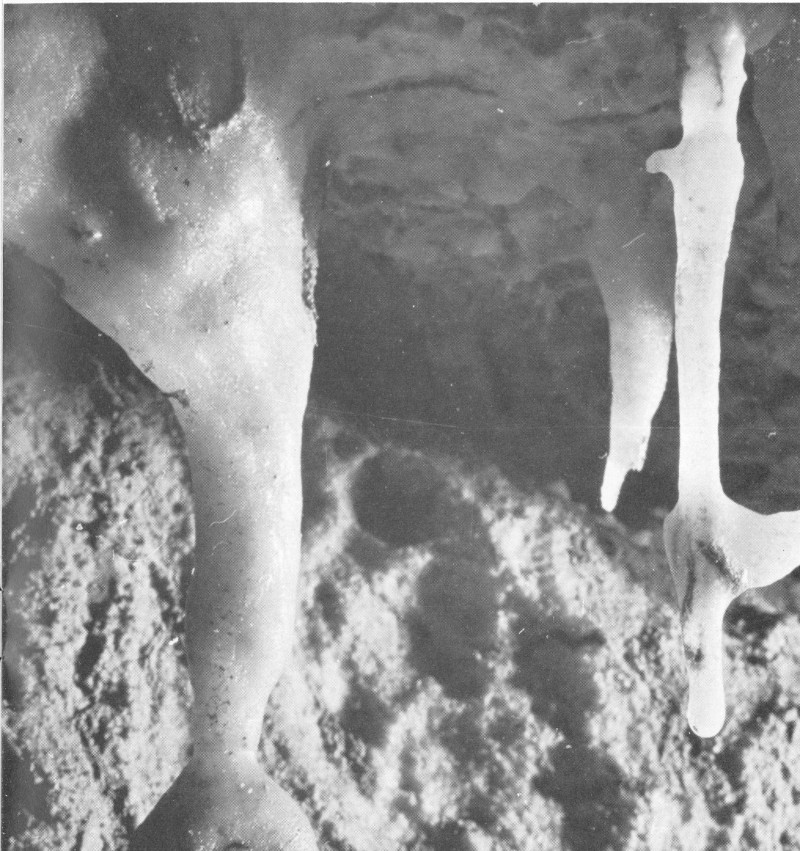
Helictite formed on soda straw
Soft, fibrous mats of calcium carbonate deposited near the surface at Oregon Caves are termed moonmilk. In time moonmilk may harden into popcorn mats. Its manner of formation is not fully understood.

Popcorn in Adam’s Tomb

Rimstone
At the “Devil’s Washboard,” and at the foot of Paradise Lost, we find still another type of speleothem—rimstone—which forms in pools of water. Agitated by dripping or flowing water, some of the carbon dioxide in the pool escapes. The resultant deposition of mineral takes place on irregularities in the bottom of the pool, or creates stone wavelets where the pool spills over. Ridges and dams subsequently build up, often constricting the pool surface (see illustration on page 22). Another type of rimstone, or cave ice, develops when flowstone builds up around the edge of a pool and gradually closes across it. The pool may be completely sealed over, just like a pond in winter, except that “cave ice” can never melt.
Cave students are often confused by another deposition found in the form of thin blades jutting out of the wall (see illustration below). They have a woven, crystalline texture. Prior to removal by solution, some of the marble cracks were filled with calcium carbonate. Being less soluble than marble, the sheets of calcite crystals remain for a time after the surrounding rock is dissolved away.
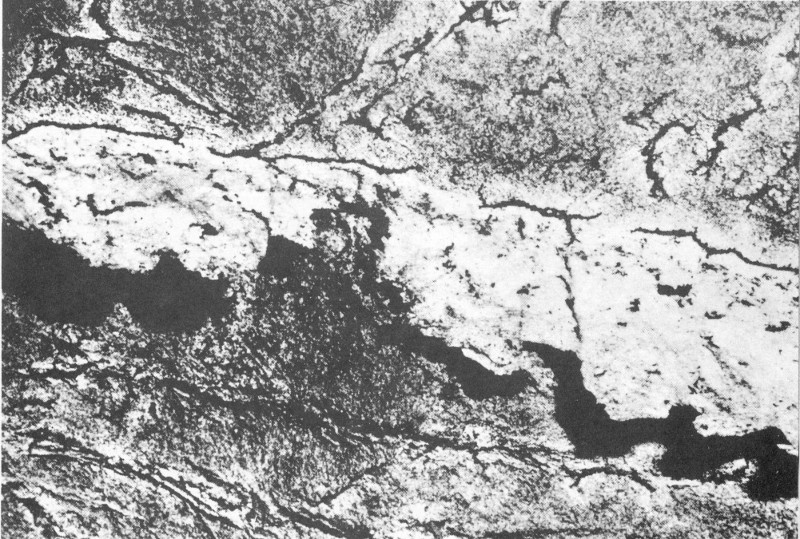
Blade formation
So far we have discussed cave features—speleothems—created by deposition of mineral from the solid to liquid, and back to solid state. But certain objects in the caves are simply what remains of a piece of marble after some of it is dissolved away. These are speleogens, cave features created by the dissolving of mineral (see illustration page 24). They 24 can be striking, but primarily it is the speleothems which make Oregon Caves a thing of wonder and beauty. The zenith of such spectacular development as seen at Paradise Lost leaves little doubt of this.
We have followed the mineral calcium carbonate through many forms: from sea creatures to ocean mud, to limestone and then marble, next to a liquid solution called calcium bicarbonate, and lastly as calcite crystals in cave formations. The size, shape and variety of cave deposits are determined by many factors which seem to prevent any two being exactly alike. Changes in temperature, relative humidity, available carbon dioxide, amounts of vadose water, air circulation, surface tension, permeability of roof rock, vegetation above the cave, bacteria action, and the amount and kind of impurities in vadose water may all combine to vary the nature of cave formations.

Detail in Paradise Lost
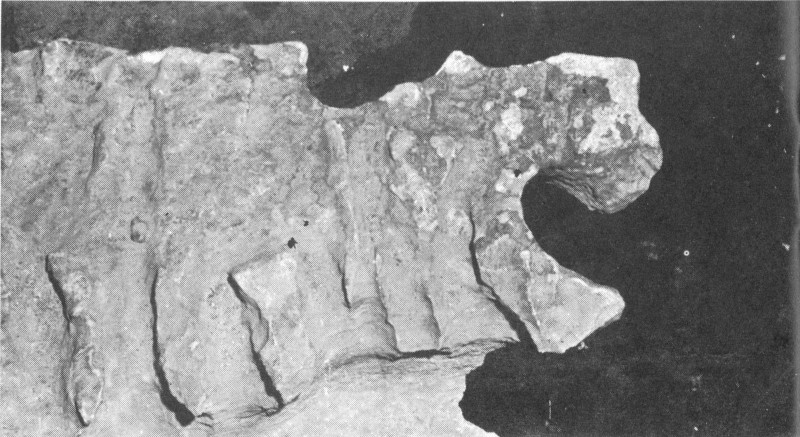
Speleogen above River Styx
The many variables make it difficult to accurately estimate the age of cave deposits. We have no way of determining past conditions which have influenced the rate of development. Oh, we know the formations are many thousands of years old, beyond that we can only guess. Some crude 25 examples of known age are the tiny, one-half-inch stalactites formed in the exit tunnel since it was completed some 38 years ago (see illustration below). Bathed in warm, dry air from the outside, they have probably developed much faster than those inside the main cave. Other active formations deep in the cave show very little visible depositing over names written on them by early explorers in the 1880’s. So the true secret of the age of the formations must rest with the cave itself. Perhaps this is best.
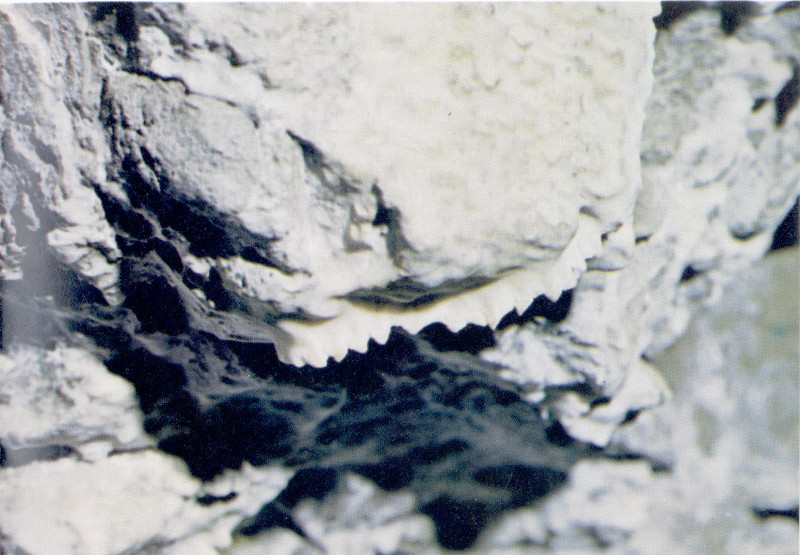
Stalactites formed since exit tunnel was completed in 1933
An obvious feature you may see in Neptune’s Grotto is the brown lacework on the walls. They are lines of clay. Molecular attraction causes the clay particles to cling together into what we call clay worms. (See illustrations on page 27). Where does the clay come from? Some of it may 26 be washed in from the ground above. The rest of it is the remnant of marble solution. Oregon Caves marble is 93 percent calcium carbonate. The remaining 7 percent is non-soluble clay and remains in the cave after the calcium carbonate is carried away in fluid state. Clay worms are temporary features; vadose water or the touch of a careless hand can easily remove them.
In the Ghost Room we find an interesting object. Projecting from the ceiling is an 8-inch thick slab of angular brown rock. Its edges have been broken, rather than dissolved. This is a clastic dike. Evidence is lacking to definitely state its origin or manner of emplacement. But at some time in the past, there was an extensive crack in the marble which was filled by a mudlike material made up of bits of quartz, plagioclase, horneblende, epidote, clay, and other minor ingredients. It may have been washed in from the surface, or it could have been injected from below by earthquake shocks which cracked the marble and forced the pliable material into the cracks.
Eventually it hardened into rock. Due to its non-soluble ingredients, the dike was not dissolved when the Ghost Room was formed. Like the “blades” we discussed previously, it remained as a projection into the room while the marble walls receded under solution activity. Being brittle, it has apparently been broken off periodically by the jar of earthquakes or cave collapse.
Another obvious discrepancy in the marble framework of the caves is the thin layer of slate found in the 65-foot tunnel. This reveals an interruption in the limestone sedimentation of the Triassic sea. A thin layer of shale was deposited between limestone layers. Later, when the limestone became marble, the shale became slate. It should be mentioned here that limestone and shale vary greatly in their contents and often interblend with each other. “Pure” limestone is white. Different shades occur with different amounts of claylike impurities. When the impurities overshadow the limestone, then the rock may be called shale. The whitest marble in Oregon Caves came from the purest limestone. The darker, blue-banded marble is rich in slate impurities.

The lacework effect of clay “worms”
If the Indians of southwest Oregon knew of Oregon Caves they left no evidence of the fact. Possibly its remote and rugged setting was too far away from their normal haunts near the fertile valleys and salmon-rich rivers. Or they may have known of the cave, but superstitions forbade their entering it. To our knowledge, Elijah Davidson was the first person to penetrate its depths.
Other creatures used it regularly. Bears, mountain lions, coyotes, bobcats, skunks and other predators found the outer chambers ideal dens or resting places. Within the “twilight zone”—the galleries near the surface where some light penetrates—rodents of several kinds entered freely and even made nests. Today, we find the industrious woodrat still gathering mounds of sticks, leaves, flashbulbs, and hairpins to store near the 110-foot exit. Mice and rabbits are frequently seen in the cave. Occasionally the tracks of the ringtail betray his secretive hunting trips into the cave. In 1935, even a mountain beaver was found in the Ghost Room.
However, there is only one mammal truly adjusted to normal living inside the dark portions of the caves. This is the bat. (See illustration below). There are eight species of bats that use Oregon Caves. Most common is the long-eared myotis. None are abundant, and most visitors do not see them, for this is not a “bat cave” in the same sense as Carlsbad and other caves. Also, the bats prefer the undisturbed sections of the caves, where people seldom enter. In spite of this, they attract much interest and are the subject of much discussion. The only mammal capable of flight, bats are also unique in their ability to fly in total darkness deep within caves.

Hibernating bat in “dry” room
This latter skill puzzled scientists for many years until, in the 1930’s, it was learned that bats navigate in darkness by echo-location, a system similar to the Navy’s sonar. The animal emits high-pitched squeaks, 29 above the threshold of human hearing. The echo of the squeaks bounces off nearby objects and the bat is able to decipher, from a flood of up to sixty echoes a second, the size, shape, and distance of objects before them. So precise is this system that the animal is able to locate and capture flying insects in pitch darkness. Not only can they navigate in the dark, they can also remember echo patterns that help them to return again and again to the same place deep inside a cave.
They feed at night, eating great numbers of insects. In winter a few of them hibernate in Oregon Caves and may be easily observed clinging head downward from the walls and ceilings for months at a time. During a bat-banding study a few years ago, 750 bats were fitted with tiny aluminum identification bands and released. To date, however, none of these bats have been found elsewhere, nor have any foreign bands turned up here. Some bats are migratory, for each year in late August or September there is an influx of several hundred that may be seen in the caves for only a few days. Then they are gone again.
Certain arthropods—millepedes, spiders, moths and small wingless insects called collemboles—are abundant in the “twilight zone” of the caves, where they feed on organic matter and upon each other. Thus animal life in the cave is more prominent than many people suspect.
When the cave lights were installed in 1932, conditions were established for the entrance of another type of life—plants. Carried into the cave by water or air currents, spores of primitive plants could now germinate and live. Near the light fixtures we find interesting colonies. The green coating several feet from the lights are clusters of algae. They have no leaves, stems or roots; in fact they are the simplest and most universal of the earth’s green plants. They require much less light energy than the mosses which grow only a few inches from the lights. In one or two places we also find fleshy green liverworts which look like blobs of spilled paint. And now and then we find the cave’s highest type of plants, the sword ferns. Diminutive in comparison with their kin outside the cave, these tiny ferns are nevertheless able to survive near the lights which burn at least part of every day during the year.
What next? Like lakes and waterfalls, caves are temporary features of the drainage pattern of an area. The same processes which produce them will eventually destroy them. At Paradise Lost we see that an appreciable part of the original room has already been filled with cave deposits. Many side passages in the caves have similarly been blocked off by the accumulation of flowstone.
On the outside, surface erosion will wear away the roof rock until the caverns collapse. The rooms will be filled with sunlight and exposed to rapid weathering. The calcium carbonate that was laid down in the Triassic sea, then lifted into mountains, then changed to calcite cave deposits, will again be dissolved by water and carried back to the sea. We know this because remnants of other caves reveal the pattern of creation and destruction common to all caves. The end will not come at Oregon Caves for thousands or millions of years. But it will come. The work of water and other erosive forces never ceases.
Oregon Caves have been known since a day in 1874 when Elijah J. Davidson went hunting in the Siskiyou Mountains. The story goes that, after killing a deer, he followed his dog to a large hole in the mountain. Here he heard sounds of fighting coming from within. Being undecided as to what to do, he stood waiting—then his dog gave vent to a weird howl, as if in great pain. Hesitating no longer, Davidson rushed into the opening. He soon found the chase difficult to pursue without a light, whereupon he resorted to a few matches that he had in his shot-pouch. Striking match after match, he expected that he would soon be at the scene of the struggle.
Before arriving there, however, his supply of matches gave out, leaving him in the dark. Davidson finally found his way back to a running stream of water, and following it, came to the mouth of the cave. Soon after, the dog came splashing down the creek, unhurt. As it was well on in the evening, Davidson decided to go back to camp and return the next day. Before leaving, however, he placed near the entrance to the cave the buck he had recently killed. He anticipated that a bear would come out for food, eat all it could and then lie down by the remaining part. Returning early the next morning, Davidson found a monstrous black bear lying near the carcass of the deer.
Davidson told others of his discovery, and the cave soon became an attraction for the adventuresome, portions of it being explored and opened. Early interest in commercializing the cave were thwarted by its remote location, far from roads and populous communities.
In 1907, Joaquin Miller, the “Poet of the Sierra,” and Chandler B. Watson, author of Prehistoric Siskiyou Island and the Marble Halls of Oregon, visited the cave. They were highly impressed and promoted the cave as the “Marble Halls of Oregon.” Public attention was aroused and the cave was established as Oregon Caves National Monument on July 12, 1909. (See illustration on page 32).
Appreciable public use was not attained until 1922, when an automobile road was completed to the caves. The next year, 1923, the Forest Service granted a concession to the Oregon Caves Company, which has provided public accommodations and cave guide service since then.
In 1933, the Monument was transferred to the National Park System. Concurrently, the completion of the 512-foot exit tunnel that same year greatly improved cave tour circulation. The public use pattern, relatively unchanged for the next three decades, was established after the opening of the concessioner’s chateau building in 1934. The chateau is noted for its charming architecture, complementing the steep, forested setting.
Oregon Caves have been set aside as a national monument because of their outstanding natural features. The National Park Service is charged by Congress to provide for the public use and enjoyment of the area “in such manner and by such means as will leave it unimpaired for ... future generations.”

A visit to Oregon Caves in 1912
Natural things and natural processes are paramount. Manmade facilities such as trails, lights and steps are necessary to allow visitors to enjoy the cave. But they are kept at a minimum. Your guide will ask you not to touch any of the cave formations. This is to keep them from being stained or broken. Prior to the establishment of the National Monument in 1909, fragile formations were the object of severe vandalism and thoughtless destruction by souvenir hunters (see illustration page 33). It is doubly important to preserve the remaining features for the benefit of those who will come here tomorrow and in later years.
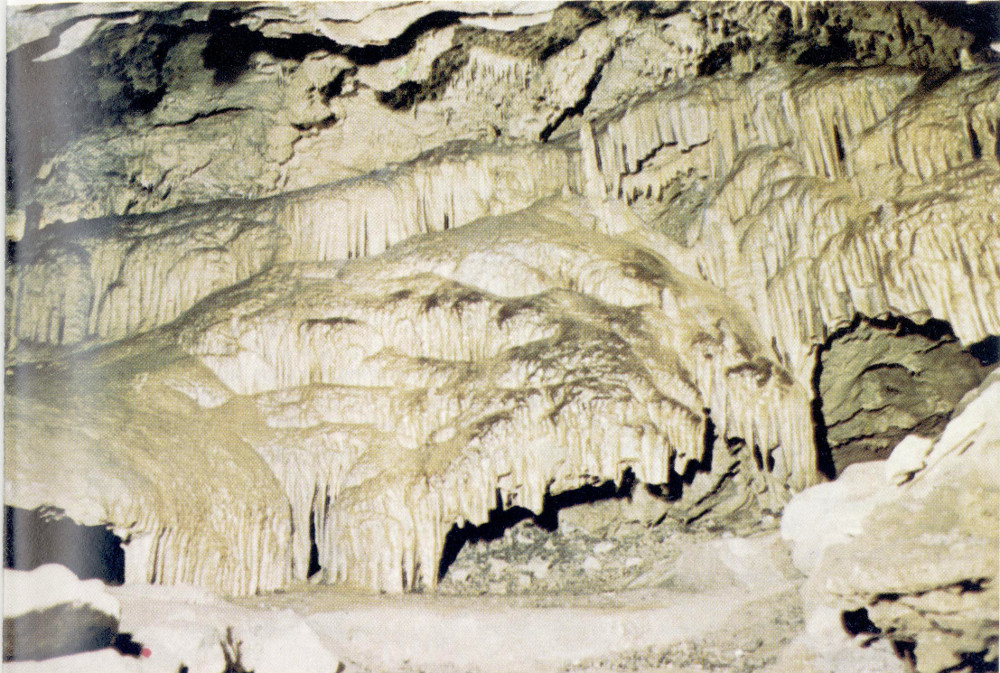
Vandalism: Nature required many thousands of years to create these stalactites. A thoughtless person needed only a few moments to destroy them.
Outside the cave, the Monument is a place where flowers are enjoyed in their natural state and not picked, where birds and wild animals are unmolested by hunters or trappers. The forest is undisturbed. On the trails away from the cave area, the hiker may see animals and plants fulfilling their existence as they did centuries ago. It is to this philosophy that the national parks and monuments are dedicated.
Bacon
A thin sheet of calcite drapery having alternating dark and light bands which give it the appearance of a strip of bacon. The dark, reddish bands are usually caused by an iron oxide stain.
Bedding plane
The stratification or meeting place of two different layers of sedimentary rock.
Blade
A calcite sheet originally deposited in a crack, then later exposed.
Breakdown
Heaps of rubble on a cavern floor caused by the collapse of walls or ceiling.
Calcium bicarbonate
An unstable compound occurring when carbonic acid contacts calcium carbonate.
Calcium carbonate
A mineral with the chemical formula CaCO₃.
Calcite
A crystalline form of calcium carbonate.
Carbonic acid
A weak acid occurring as a liquid, having the formula H₂CO₃, a mixture of carbon dioxide and water.
Clastic dike
A dike made up of fragments of pre-existing rocks.
Column
A speleothem formed when a stalactite and a stalagmite meet.
Deposit
A natural occurrence of mineral material, such as an iron ore deposit; or in the vocabulary of the speleologist, any cave formation originating from deposition.
Drapery
Hanging speleothem in the form of a curtain or drape.
Dripstone
A calcite deposit left by dripping water.
Flowstone
A calcite deposit left by flowing water along a cave wall or floor.
Fracture
A break in rock.
Gallery
An underground passage.
Ground water
Water within the earth, such as feeds wells.
Helictite
A variant form of stalactite which does not hang vertically or which has side growths resembling twisted roots.
Joint
A crack, which in limestone forms at an angle to a bedding plane. A series of joints often intersect each other in a four-sided pattern.
Limestone
A rock consisting chiefly of calcium carbonate, usually an accumulation of organic remains such as shells.
Marble
Limestone crystallized by metamorphism.
Metamorphose
To change into a different form, such as changing sedimentary rock (limestone) into a metamorphic rock (marble).
Moonmilk
A rare form of hydromagnesite or calcium carbonate which is semisolid.
Phreatic zone
The region, below the water table, in which rock is saturated with water.
Popcorn
Nodules of mineral deposits formed in such a way as to resemble popcorn.
Rimstone
A calcite deposit around the edge of a pool of water.
Sedimentary rock
Formed from deposits of sediments or from fragments of other minerals.
Shale
A sedimentary rock formed from deposits of clay or silt.
Solution
The process by which a substance is chemically combined with a liquid. Also, the state of being chemically so combined.
Soda straw
A small, hollow stalactite inside which drops of water descend.
Speleogen
A cave feature produced by solution of base rock.
Speleologist
One who makes a scientific study of caves.
Speleology
The scientific study of caves in all their aspects.
Speleothem
A cave feature produced by deposition of mineral.
Spelunker
One who explores caves as a sportsman or amateur speleologist.
Stalactite
A calcite speleothem which grows downward, icicle-fashion, as a result of deposition by dripping water.
Stalagmite
A calcite speleothem which grows upward from a cave floor as a result of deposition by dripping water.
Vadose zone
The region lying between the surface of the earth and the water table. Water which seeps or flows through this region under the pull of gravity is called vadose water.
Water table
The meeting place of the phreatic and vadose zones. Below it, the rock is saturated with water; above it, water under the pull of gravity is continuously flowing downward.
Davidson, E. J., “History of the Discovery of the Marble Halls of Oregon.” Oregon Historical Quarterly, Vol. 23, pp. 274-276 (1922).
Folsom, Franklin, Exploring American Caves. New York, Crown Publishers, Inc., 1956.
Halliday, William R., Adventure Is Underground. New York, Harper and Brothers, Publishers, 1959.
Mohr, Charles E., and Howard N. Sloane, Celebrated American Caves. New Jersey, Rutgers University Press, 1955.
Wells, Francis G., Preliminary geological map of southwest Oregon. U.S.G.S. Mineral Investigation Map, MF 38, 1955.
1. No person shall enter Oregon Caves unless accompanied by an authorized guide.
2. Children under 6 years of age are not permitted in the caves. A nursery is provided.
3. The destruction, injury, defacement or removal of any of the natural features, rocks, plants, or animals in the caves or Monument is prohibited.
4. No canes, umbrellas or sticks of any kind may be taken into the caves.
5. Dogs and cats must be kept under physical control and are not allowed on trails or in the buildings.
6. Careless disposal of trash is prohibited; please use the containers placed nearby.
THIS IS YOUR NATIONAL MONUMENT
Please help keep it clean and undamaged for those who follow you.
Oregon Caves National Monument is a unit of the National Park Service. Inquiries should be addressed to the Park Manager, Oregon Caves National Monument, P.O. Box 377, Cave Junction, Oregon 97523.
